|
|

|
NASA exhibit 'covers' space history
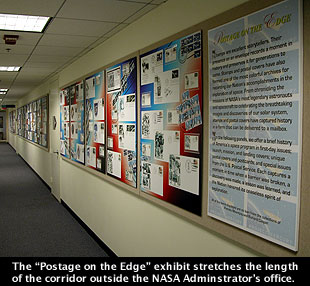
August 1, 2003 — Since 2001, the corridor outside of the NASA Administrator's suite has had artwork, photographs and other imagery displayed on the wall to greet visitor's as they go into the Administrator's office.
After seeing some of the previous exhibits that had been featured in the corridor (i.e., NASA at the Movies; imagery describing NASA's Strategic Plan and the Agency's future), NASA Senior Policy Analyst Richard Cooper met with NASA Art Program manager Bert Ulrich to see about displaying NASA's history in stamps and covers. After getting a green light from management to proceed, both Cooper and Ulrich met with the staff of NASA Printing and Design at NASA Headquarters who took the idea and created the exhibit using covers from Cooper's personal collection.
The result of their work is "Postage on the Edge", an exhibit that tells the story of America's space program in first day Issues; launch, mission and landing covers; unique postal covers and postcards; and special issues from the US Postal Service. In the words of the exhibit's opening panel, "each of the displayed items captures a moment in time when a barrier was broken, a discovery was made, a lesson was learned, and a Nation honored its ceaseless spirit of exploration."
Last month, Cooper invited collectSPACE to tour the exhibit and spoke about the project, collecting and NASA.
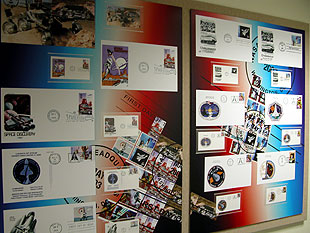
How was the exhibit constructed? Who was involved?
The items displayed are from my personal collection and that of Pam Mountjoy, who I worked with in NASA's Education Programs until her passing in September 2002.
The people who really made this exhibit happen though are Mike Barnes, Senior Graphics Designer with NASA Headquarters' Printing and Design Office and Bert Ulrich, who leads NASA's Art Program.
As to the exhibit's construction, it is mounted on the Administrator's corridor wall on to printed foam core and through the ingenuity of Mike Barnes and the NASA Printing and Design team, they scanned a number of the featured covers and printed them out to be the exact dimensions and colors of the original covers. Mike and the Design team then cut them out and mounted them onto the panels with a piece of cellophane over them to give viewers the impression that the actual covers are mounted on the walls but in fact, they are just excellent copies meant to give that "real" impression.
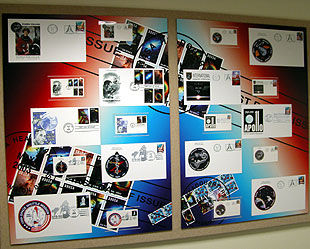
How did you select which covers to include?
When I began to work with Mike Barnes of NASA's Printing and Design Shop, I was asked by him to select the covers that I thought best told NASA's story.
What we agreed on was to start with the Echo Cover (1960) and go up to the present day. We ended the exhibit with STS-109, Columbia's last successful mission (2002) because that was the most recent cover I had (at the time), plus it was signed by the crew.
I also referred Mike to covers that I thought showed variety and color but I left the decision on which ones to include up to him. As the artist behind the exhibit, I wanted him to have the freedom to pick what he thought would work best and the results speak for themselves.
He did a fantastic job with the entire layout and presentation. I've received an awful lot of complements on the exhibit but it's Mike, Bert Ulrich and the folks at NASA's Printing and Design Shop that deserve the true credit.
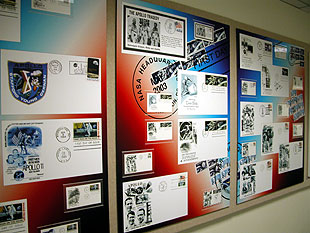
What has been the reaction (direct feedback, heard in the hallways, etc.)?
The feedback has been overwhelmingly positive and many times down right flattering. When the exhibit first went up in late June, I heard a lot of, "I've never seen anything like this," or "Where did you get all of these?"
People were generally stunned at the color, variety and the history that could be told by simple stamp, postmark and envelope. In fact, a number of persons stopped me to say that they did not know about the space covers or the fact that so much of NASA's history could be recorded in such a way. A lot of folks though remarked about the wide variety of covers, or the fact that a number of the covers were so unique or were signed by astronauts or other NASA legends.
Most though wanted to know how I was able to collect the covers and get so many of them signed.
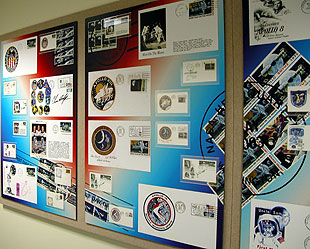
What is the plan for the exhibit (how long will it be in place; where is it going next)?
The exhibit went on display in mid-June and is scheduled to be on display until the end of August.
There has been some preliminary discussion that the exhibit will be shared with some of the other NASA Centers' Visitor Centers but no decision has been made yet.
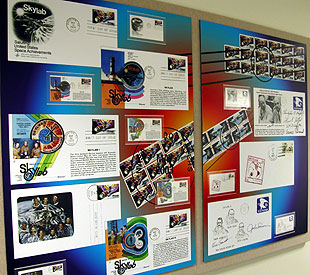
How did you start collecting covers?
I actually fell into collecting covers by accident by attending the first Shuttle launch I witnessed firsthand (STS-48, September 12, 1991). The gentleman who I was working for at the time (Mike Smith, who is now working at JSC) introduced me to the covers and explained to me how they were postmarked the date of the launch. I thought it would be a pretty neat keepsake to remind me of one of the most memorable sights I had ever seen.
As I attended different launches, I got a few more but it really wasn't until about five to six years ago that I really started actively collecting covers. As I began to accrue items to my space memorabilia collection (i.e. signed photos, patches, posters, etc.) I began to focus on the covers as an inexpensive and unique way to record the story of America in space.
Since then I've added to my collection with the guidance of Mr. Kennedy of Kennedy's Stamp and Coins and the friendly guys at Century Stamps & Coins, both in Springfield, Virginia.
A number of friends at NASA have also helped me out but a significant portion of my collection though comes courtesy my friend Pam Mountjoy.
I first met Pam in 2001 but it was when I joined NASA's Education Office in 2002 that I really had an opportunity to get to know her. Pam was a former elementary school teacher in Prince Georges County, Maryland who had worked with NASA to support Teacher in Space Program back in the early and mid-1980s. She eventually joined the Agency full-time and served in its Education Program as one of its most creative and energetic leaders.
Pam also had this amazing collection of space toys and related memorabilia and one day over a conversation I discovered that she also collected the space covers. This was the first time I had encountered anyone with a similar collection and we agreed to sit down and see if there was anything we might be able to trade with one another.
Much to my surprise, the next day she appeared at my desk with a postal cover binder and said, "Here." I was dumbfounded. Instead of swapping a few covers, she said, "Take them. You're the only other person I know that collects these and they'll have a good home with you." It was a stunning gift and one that I will always be grateful to her for. She was an amazing person and would have loved the exhibit. In many ways, I look at the exhibit as a tribute to her and her generosity not just to me, but to many of the folks at NASA and elsewhere that she touched.
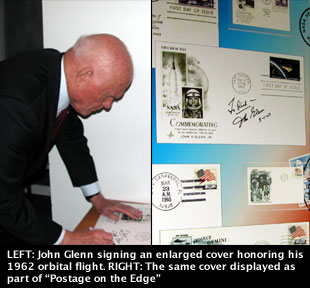
What is your favorite cover in the exhibit? in your collection? Why?
I am partial to the STS-26 launch cover particularly since it is signed by the entire Return to Flight crew but I'm also pretty enthusiastic about the Apollo Soyuz Test Project Postcard that I have which is signed by the US crew (Stafford, Lousma, Slayton) as well as Chris Kraft.
But if there is ever a fire and I have grab just one, I would have to say it would be the enlarged version of the John Glenn, Mercury First Day Cover which he graciously signed for me on Space Day this past year. He said he had never seen a cover blown up like that before and it was a real thrill to have him sign it. He was incredibly gracious and it meant an awful lot to me to have him take a moment to do that for me.
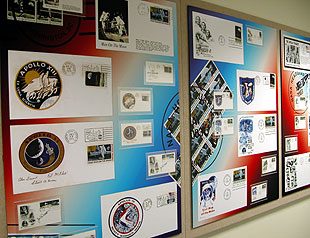
What cover are you missing that you would desire most?
I would love to get a Mercury 3 cover (Alan Shepard's launch) as well as a complete set of Mercury launch covers but my big quest at the moment is an STS-1 launch cover. Eventually I would like to have a cover from each of the US manned missions but know that is going to take some time as well as serious cash.
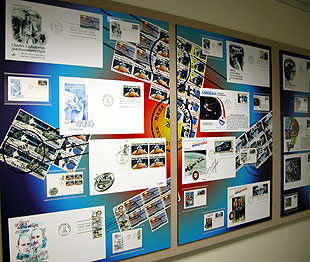
What about covers do you think attracts collectors?
Variety, rarity and the story they tell.
There is probably not a person in this country, or for that matter the world who has not encountered a stamp or an envelope. To collectors, a stamp, an envelope and a postmark can tell a story in ways other media can't. Furthermore, they are still an accessible collectible (for the most part).
Today so many collectibles are out of reach to kids, or for that matter adults by nature of their cost, or just their ability to find them. (Look at what has happened to sports memorabilia in the past 10 years.) Postal covers are for the most part pretty inexpensive and there isn't a country or state that you can't go to and find something unique.
I can't tell you how many Stamp & Coin shops I have gone into where I've been able to find at least one unique space cover. That has been part of the fun in collecting them because you never know what you might find and most of the time, you can find something under $10.00. You can't do that with most collectibles anymore.
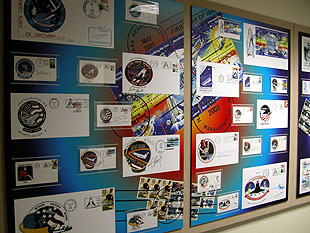
What advice would you give to a new cover collector?
Follow your interest and do your research along the way. Nobody in forming a collection should feel bound to one track of interest.
Go with what interests you. For me, its US space accomplishments. To others it may be Soviet/Russian covers but go with what excites you.
As to getting started though, I would encourage a prospective collector to make use of collectSPACE and the Space Unit.
The collectSPACE website was a huge help in helping me to assemble my current collection and I still look at it regularly for help. In fact, collectSPACE introduced me to Ray Cartier and the Space Unit who have been an enormous resource for additional (and rare) covers as well information on the other aspects of cover collecting. Both are resources that have made me a smarter collector and helped me expand what I've been able to gather over the past several years.
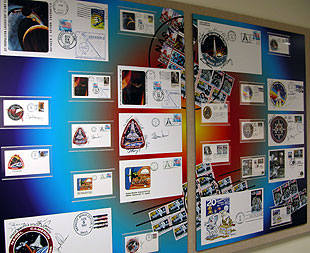
What advice would you give to someone wanting to exhibit their collection?
Find an appropriate and safe venue for display, find someone you can trust to help design the exhibit and have the buy-in of management to allow things to go forward.
Bert Ulrich, Mike Barnes and the entire NASA Printing and Design Team were exceptional to work with and made the assembly of the exhibit very easy. I knew with both of them involved, the exhibit would be great but importantly to me, I felt comfortable entrusting them with my collection so that it could be scanned and referred to as they built it.
Bert, Mike and I were also very fortunate that we had the exhibit area to showcase the covers and there was an interest and willingness by NASA's management to allow it to happen. All of those factors combined to make this effort a success.
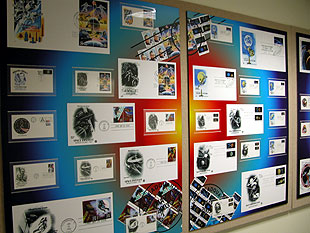
What role do you think collectors have in promoting NASA mission and vision?
NASA to many people is a foreign entity that they don't really understand or appreciate but a collector can often help make the Agency more accessible and understandable.
Most of today's public will never have the opportunity to own, touch or encounter a piece of NASA but a collector can give those persons such an opportunity by sharing their collection whether through a private or public venue. The Agency has gone to great lengths the past several years to better communicate its vision and mission and share its programs in more "human" and reachable terms but collectors are "grass-roots" people distributed around the country and world who can help NASA better perform that job on a daily basis.
It's also been my perspective that collectors are the "true believers" in what NASA does and best understand what the Agency's purpose. They are also usually the first group to grasp the history, the awe and the magnitude of what the Agency does on a regular basis. To some folks, a signed astronaut picture is a nice gesture from a personal encounter, or a space cover is just a colorful envelope and stamp that have been cancelled. To a space collector though that signed picture is a prize from a pioneer of the new and challenging frontier of space and that space cover and stamp is a record a moment in time when our life was changed.
Richard Cooper works in the Office of Public Affairs as the Senior Policy Analyst. He joined the Office just as the Columbia accident occurred and have been supporting accident-related activities ever since. Prior to that Cooper worked in NASA's Office of Education as the Program Manager for the Educator Astronaut Program and as a Special Assistant to the NASA Administrator and Chief of Staff/White House Liaison. |
back to News

© 2023 collectSPACE.com All rights reserved.
Questions? E-mail contact@collectspace.com

|
|

|

|
